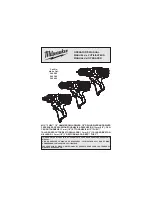
12
| English
1 609 92A 3A3 | (19.8.16)
Bosch Power Tools
Fasten the drill stand (with drill inserted) using anchors or
vacuum so that the mounted core bit is aligned with the
marked dimensions.
Fastening with Anchor (see figure B)
For fastening of the drill stand to brickwork or concrete with
anchor (accessory), drill a separate anchor hole.
The following dimensions apply for the anchor hole:
Insert a concrete hammer-drive anchor or a brickwork anchor
16
. Screw the quick-clamping spindle
17
into the anchor.
Position the drill stand, attach a washer, and then screw to-
gether with the wing nut
18
. After levelling (see “Levelling”),
tighten the wing nut using an open-end spanner, size 27 mm.
Fastening with Vacuum (Accessory)
To fasten the drill stand with vacuum, you require a conven-
tional vacuum pump and a Bosch vacuum set (accessory).
The vacuum pump must meet the following minimum require-
ments:
The surface must be smooth and flat in order to fasten with
vacuum. Use on plaster or brickwork is not permitted.
Once the vacuum connection has been established, apply the
levelling screws
6
lightly to the surface so that the drill stand
is in a rigid position and the sealing ring relaxes slightly. Oth-
erwise the drill stand will sit very softly on the sealing ring.
Read and observe the operating instructions of the vacuum
pump and Bosch vacuum set in order to connect them.
The safety and operating instructions for the vacuum
pump and vacuum set are to be strictly observed!
Levelling (does not apply for fastening with vacuum)
Turn the levelling screws
6
in or out individually until the spirit
level
14
on the drill (when mounting vertically) or the spirit
level
15
on the drill (when mounting horizontally) is precisely
aligned.
Now fix the drill stand firmly using anchor attachment.
Operation
Disconnect the plug from the power source before
making any adjustments or changing accessories.
Starting drills accidentally is the cause of some accidents.
After each adjustment on the drill stand, firmly retight-
en all screws.
Drilling-angle Adjustment
Loosen the lower screw
8
of the drilling-angle adjustment
using an open-end spanner (size 17 mm) and take it off.
Loosen the upper screw
5
using an open-end spanner (size
17 mm).
Loosen the clamping nut
11
using an open-end spanner (size
24 mm). Set the drill stand to the required drilling angle.
Retighten the clamping nut
11
using the open-end spanner.
Tighten the upper screw
5
using an open-end spanner (size
17 mm).
The drill stand must not be inserted until the clamping
nut 11 and screw 5 of the angle adjustment have been
retightened.
After drilling, put the drilling column
4
back in the vertical po-
sition in reverse order (drilling angle of 0°). To do so, you have
to insert the lower screw
8
again and tighten it using an open-
end spanner (size 17 mm).
Water Extraction
You require a water collection ring and a wet/dry vacuum
cleaner (both accessories) to collect the water escaping from
the bore hole during wet drilling.
The water collection ring (see “Accessories”, page 13) is in-
tended for use with the drill stand for diamond drills GCR 180
and the diamond drill GDB 180 WE.
Mounting the Water Collection Ring (see figure C)
Cut an opening for the required drilling diameter in the seal-
ing lid.
Slide the tension spring
19
all the way into the gap between
the bottom plate
9
and the drilling column
4
. Ensure that the
angled part of the tension spring faces downwards.
Bring the water collection ring into position and place the ten-
sion spring on the contact points on the water collection ring.
(The lugs on the ends of the tension spring are used to pull the
tension spring upwards.)
The tensioning force of the spring will press the water collec-
tion ring with its seal onto the surface and together with the
vacuum of the wet/dry vacuum cleaner will prevent water
from escaping.
Working Advice
For drilling, observe the operating instructions of your
diamond drill.
To drill, loosen the parking brake
13
until the star handle
1
is
easy to move. When doing so, hold the star handle in place in
order to prevent the drill from sliding down in an uncontrolled
manner.
Use the star handle
1
to turn the drill down to the required
drilling depth.
Then, turn the crank back until the core bit is completely visible.
To achieve the maximum possible working length, you have to
remove the drill core as soon as it completely fills the core bit.
Then feed the core bit back into the bore hole and drill to the
maximum depth.
Clearance from anchor hole–centre of the intended bore
hole
optimal
210 mm
possible
200–300 mm
Diameter
Depth
Brickwork
20 mm
85 mm
Concrete
16 mm
50 mm
Volume flow:
6 m
3
/h
Vacuum at least:
80 % (–800 mbar)
OBJ_BUCH-2243-002.book Page 12 Friday, August 19, 2016 10:34 AM













































